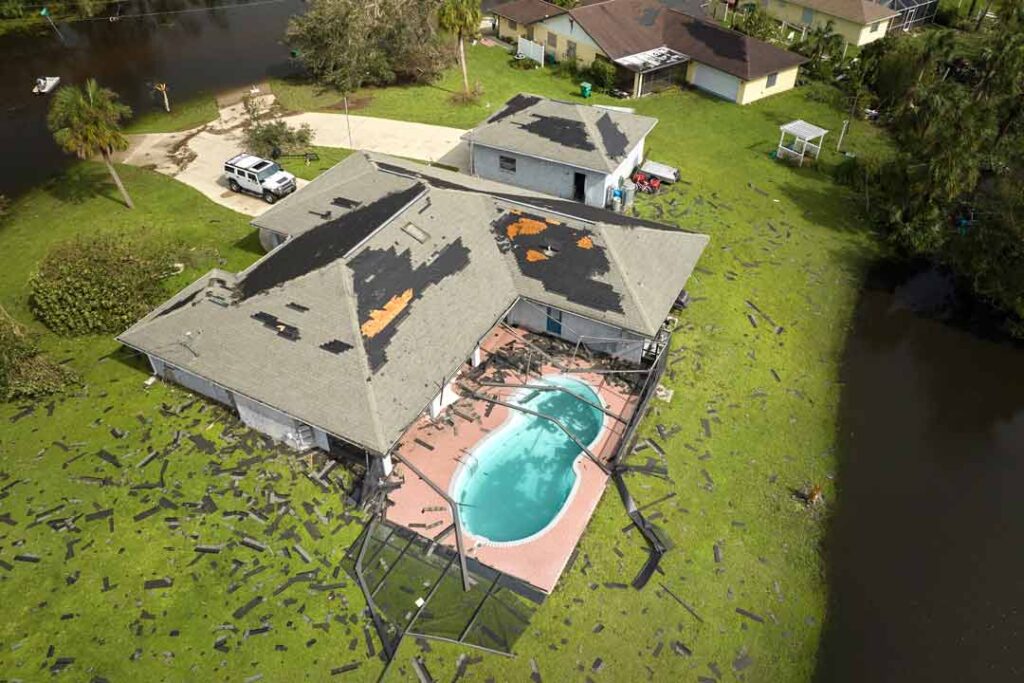If your home or property has been damaged, you’ll need to file a claim with your insurance company. The claims process can be confusing and overwhelming, but it doesn’t have to be.
This article will provide a step-by-step overview of the claims process, as well as some tips on what to do during each step.
Keep in mind that the process may vary slightly depending on the severity of the damage and your insurance company’s policies.
If you have suffered damage from a hurricane, you will need to file an insurance claim. This process can be confusing, so we are here to help.

Step 1: File Your Claim
What to Expect When Filing Your Claim:
You should file your claim with your insurance carrier directly. We have a list of where to go for your claims department depending on which carrier you have.
When you report your claim, you will receive a claim number pretty much immediately.
You should receive the claims number either over the phone or through your email address.
Keep your claim number on hand by either writing it down or making a note of it somewhere.
Based on the information you provide, your claim will be assigned a severity code and routed to a claims team.
Uninhabitable properties and claims with extensive damages are usually given a higher priority.
You will be contacted by your adjuster in a few days to schedule an inspection.
What to Do:
Take emergency measures to protect your home and stop additional destruction if it is safe to do so.
Before making any repairs or removing damaged items, take photos or videos.
To document the damages for your insurance claim, make a list of all the damaged items and keep them in a safe place where your adjuster can inspect them.
Keep track of your spending by holding on to receipts and invoices for living expenses and emergency repairs.
Step 2: Claims Inspection
What to Expect:
The next step in the claims process is the inspection. An insurance adjuster will come to your home or property to assess the damage. Usually, the inspection will take about 30 minutes to an hour.
Before they arrive, it’s important to make sure that the area is safe and accessible. If possible, you should also take photos or videos of the damage. The adjuster will use these photos to help determine the extent of the damage and how much it will cost to repair.
After you report a claim, an insurance company will send an adjuster to your property to inspect the damage. The adjuster will inspect both the interior and exterior of your property, as well as collect any photos, receipts, and repair estimates you have. The adjuster may take additional photos and ask you questions about how and when the damage happened for the claim file. This information will be used to determine coverage, assess damages and prepare a repair estimate.
If you have significant damage or report a claim after a major event, such as a hurricane, it may take longer for your adjuster to contact you and/or your property to be inspected.
What to Do:
Before meeting with your insurance adjuster, create a comprehensive list of questions to ask them during the inspection.
Make sure to provide your adjuster with copies of any receipts for emergency repairs or additional living expenses, photos of damaged items, and cost estimates for permanent repairs (if available) during the inspection.
If any of your belongings were too damaged to keep, be sure to have them on hand to show your adjuster if they ask.
Step 3: Claims Adjuster Review
What to Expect During the Claims Adjuster Review:
After an insurance adjuster conducts an inspection, they will review the gathered information to determine what coverage is available under your policy.
The adjuster will then contact you to discuss your claim, review the estimate, and finalize the claim.
After your inspection and claim review, your insurance adjuster or carrier will finalize and approve your claim for payment.
This process usually takes a few weeks, but it can take longer after a mass-level event such as a hurricane.
Once the claim has been finalized, you will receive a claim summary review letter and supporting documents. If the loss is covered and the cost of damage is more than your deductible, the claim summary letter will include payment. If the damage is not covered under your policy, the insurance carrier will explain in writing.
What to Do While During the Claims Adjuster Review:
If you find additional damage during the repair process, it is important to let your insurance agent know immediately.
Your contractor should document and photograph the additional damage with a supplemental estimate to submit to your adjuster for review and consideration.
Your contractor should not perform the additional damage repairs until your insurance carrier adjuster has an opportunity to evaluate the supplemental claim presentation. This will help ensure that you are compensated for all of the damage that has been done.
If your contractor does not follow these procedures, you may not be reimbursed for the full cost of repairs.
Step 4: Claims Payment
What to Expect with Your Claims Settlement:
Several factors will determine your initial claim payment.
Your insurance company will give you an estimate for repairing your damaged property, based on the cost of similar materials and labor in your area.
The Actual Cash Value (ACV) of the damaged covered property minus your policy deductible is your initial claim payment.
If you have Replacement Cost coverage under your policy, a recoverable depreciation payment will be issued to you after proof that repairs have been completed is received. Your insurance carrier will mail your claim check to your current mailing address.
If you have a mortgage company listed on your policy, Florida law requires that your insurance carrier include the company on your claim payment check.
In most cases, if repairs are being made to your property, the mortgage company will endorse the check and forward it to the contractor performing the work.
If you have any questions about your claim payment, please contact your claims adjuster.
What to Do:
- If you have had to change your address—even temporarily—make sure to update your insurance company with your current mailing information.
- All payees listed on the check, including any mortgage company, must sign the check according to bank requirements. To learn about your mortgage company’s procedures for endorsing claim checks, reach out to them directly.
- Make sure to keep in touch with your agent and provide documented evidence of repairs once they have been carried out.
Step 5: Repairing Your Property
What to Expect While Making Repairs:
The final step in the process is making the necessary repairs to your home or property. If you’re using a contractor, be sure to get everything in writing before work begins. This includes a detailed estimate of all costs associated with the repairs. Once work is complete, be sure to send photos or videos of the completed repairs to your insurance company so that they can close out your claim file.
What to Do During the Repair Process:
If you find additional damage during the repair process, it is important to let your insurance agent know immediately.
Your contractor should document and photograph the additional damage with a supplemental estimate to submit to your adjuster for review and consideration.
Your contractor should not perform the additional damage repairs until your insurance carrier adjuster has an opportunity to evaluate the supplemental claim presentation. By taking this action, you can rest assured that you will be financially compensated for the damage done.
If your contractor does not follow these procedures, you may not be reimbursed for the full cost of repairs.
How long does an insurance company have to investigate a claim in Florida?
If you have filed an insurance claim in Florida, the insurer must make a decision within a 90-day period. You should receive notice of the insurer’s decision within this timeframe.
No one wants to go through the process of filing an insurance claim, but knowing what to expect can make things a little bit easier. This article provides a detailed overview of the four steps of the claims process-inspection, adjuster review, payment, and repairs-and offers tips on what to do and not do during each step.
Keep in mind that the claims process can vary depending on your situation and the insurance company involved. If you have any questions about your claim payment or need help making repairs, don’t hesitate to reach out to your agent or claims adjuster.









